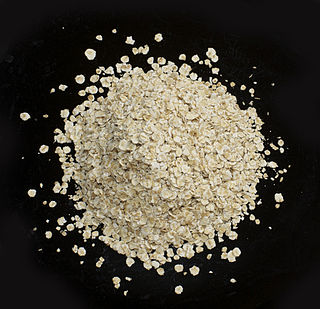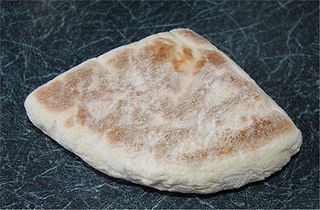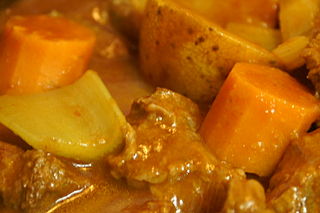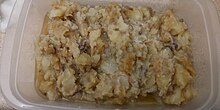
Oatmeal is a preparation of oats that have been de-husked, steamed, and flattened, or a coarse flour of hulled oat grains (groats) that have either been milled (ground), rolled, or steel-cut. Ground oats are also called white oats. Steel-cut oats are known as coarse oatmeal, Irish oatmeal, or pinhead oats. Rolled oats were traditionally thick old-fashioned oats, but can be made thinner or smaller, and may be categorized as quick oatmeal or instant oatmeal depending on the cooking time required, which is determined by the size of the oats and the amount of precooking.

Lancashire hotpot is a stew originating in Lancashire in the North West of England. It consists of lamb or mutton and onion, topped with sliced potatoes and slowly baked in a pot at a low heat.

A pancake is a flat cake, often thin and round, prepared from a starch-based batter that may contain eggs, milk and butter, and then cooked on a hot surface such as a griddle or frying pan. It is a type of batter bread. Archaeological evidence suggests that pancakes were probably eaten in prehistoric societies.

Bosnian pot is a Bosnian stew, a culinary speciality appreciated for its rich taste and flexibility. Recipes for Bosanski lonac vary greatly according to personal and regional preference, but the main ingredients generally include chunked meat and vegetables. Mixed meats may be used in the dish. It has been described as a national dish of Bosnia.

A farl is any of various quadrant-shaped flatbreads and cakes, traditionally made by cutting a round into four pieces. In Ulster, the term generally refers to soda bread and, less commonly, potato bread, which are also ingredients of an Ulster fry.

Tablet is a medium-hard, sugary confection from Scotland. Tablet is usually made from sugar, condensed milk, and butter, which is boiled to a soft-ball stage and allowed to crystallise. It is often flavoured with vanilla and sometimes has nut pieces in it.

Scouse is a type of stew - typically made from chunks of meat with potatoes, carrots and onion. It is particularly associated with the port of Liverpool, hence the inhabitants of that city are often referred to as "scousers". The word "scouse" comes from lobscouse, a stew commonly eaten by sailors throughout northern Europe in the past, and surviving in different forms there today.

Colcannon is a traditional Irish dish of mashed potatoes with cabbage. It is a popular dish on Saint Patrick's Day and on the feast day of St. Brigid.

Beef bourguignon or bœuf bourguignon, also called beef Burgundy, and bœuf à la Bourguignonne, is a French beef stew braised in red wine, often red Burgundy, and beef stock, typically flavored with carrots, onions, garlic, and a bouquet garni, and garnished with pearl onions, mushrooms, and bacon. A similar dish using a piece of braised beef with the same garnish is pièce de bœuf à la bourguignonne.
Skirlie is a Scottish dish, made from oatmeal fried with fat, onions and seasonings. The "skirl" indicates the noise made by the frying ingredients. Similar to white pudding, which has similar ingredients but is boiled in a tripe skin, it is served as a side-dish with potatoes, or used as a stuffing for chicken or other fowl. It is also a common side dish to accompany mince and tatties or Christmas dinner, especially in the northeast of Scotland. Suet, lard, beef dripping or butter are used. The addition of salt at the cooking stage is crucial, but a bit less than used to be added as salt is to be found in so many other foods.

Scottish cuisine encompasses the cooking styles, traditions and recipes associated with Scotland. It has distinctive attributes and recipes of its own, but also shares much with other British and wider European cuisine as a result of local, regional, and continental influences—both ancient and modern.
Florence Marian McNeill, was a Scottish folklorist, author, editor, suffragist and political activist. She is best known for writing The Silver Bough, a four-volume study of Scottish folklore; also The Scots Kitchen and Scots Cellar: Its Traditions and Lore with Old-time Recipes.

Mince and tatties is a Scottish dish which consists of ground beef and mashed potato. Other vegetables or thickening agents are sometimes added to the dish as well. The dish is also part of Jamaican cuisine, having been introduced to the island by Scottish immigrants to Jamaica during the 18th and 19th centuries, and was frequently served as part of school meals in Scotland during the 20th century.

Clapshot is a traditional Scottish dish that originated in Orkney and may be served with haggis, oatcakes, mince, sausages or cold meat. It is created by the combined mashing of swede turnips and potatoes with the addition of chives, butter or dripping, salt and pepper; some versions include onions. The name is Orcadian in origin.
There are many geographically indicated foods of the United Kingdom. In British cuisine, there is a custom of naming foodstuffs with reference to their place of origin. However, there are other reasons for this practice; Scotch egg, which was invented in London and Dover sole which indicates where they were landed, for example.
Hodge-podge or hotch potch is a soup or stew, usually based on diced mutton or other meat, with green and root vegetables. It is familiar in different versions in Britain and North America and is particularly associated with Scotland.

An oatcake is a type of flatbread similar to a cracker or biscuit, or in some versions takes the form of a pancake. They are prepared with oatmeal as the primary ingredient, and sometimes include plain or wholemeal flour as well. Oatcakes are cooked on a griddle or baked in an oven.

Reestit mutton is a type of salted mutton traditional to the Shetland Islands, Scotland. It has been termed "Shetland's national dish"
Hatted kit, or hattit kit, is a traditional Scottish milk dish. The fresh milk used in the recipe must be warm and traditionally it was made by milking straight from a cow into a pail or other vessel containing fresh buttermilk and sometimes rennet. Recipes variously instruct to mix well or to refrain from stirring. More milk was added at the next milking. The resultant "hat" that floats atop the whey is then skimmed off and mixed with sugar, nutmeg or cinnamon and sometimes wine. The hatted kit tends to become more acid, so limewater or charcoal may be added with later use of a batch. It may be served with cream, stewed fruit or with brown bread and salt, instead of butter.
















